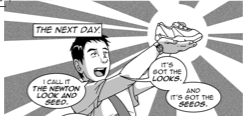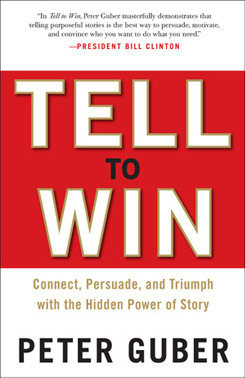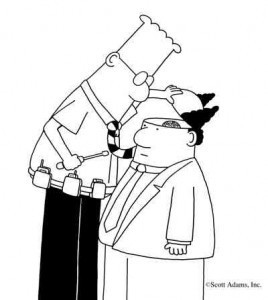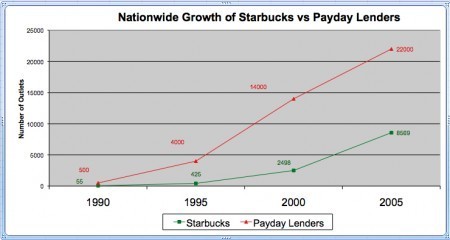Daniel H. Pink's Blog, page 17
March 23, 2011
Seed-spewing, biogegradable shoes?
 In The Adventures of Johnny Bunko, our hero comes up with what he thinks is a revolutionary, category-busting new idea. Inspired by a passing bird, he decides that his company should make shoes with seeds embedded in them. As the shoe wears out, the seeds are distributed wherever the owner happens to walk. And when the shoes wear completely out, people can plant them.
In The Adventures of Johnny Bunko, our hero comes up with what he thinks is a revolutionary, category-busting new idea. Inspired by a passing bird, he decides that his company should make shoes with seeds embedded in them. As the shoe wears out, the seeds are distributed wherever the owner happens to walk. And when the shoes wear completely out, people can plant them.
Careful readers will remember that this idea becomes turns out to be a colossal flop. But now Johnny just might get the last laugh.
Springwise reports that this month OAT Shoes will be debuting a new line of biodegradable sneakers: "Bury them in the garden, woods or compost, water regularly and flowers will bloom from your old kicks!"
Yes, life imitates manga.
March 16, 2011
Does giving teachers bonuses improve student performance?
 One of the hottest ideas in education policy these days is tying teacher pay to student performance on standardized tests. The theory is that offering up cash bonuses will prompt unmotivated and unaccountable teachers get their acts together and do better by our kids.
One of the hottest ideas in education policy these days is tying teacher pay to student performance on standardized tests. The theory is that offering up cash bonuses will prompt unmotivated and unaccountable teachers get their acts together and do better by our kids.
The first comprehensive study of this approach, from the Nashville public schools, showed an effect somewhere between minuscule and nonexistent. The students of incentivized teachers did no better than the students of teachers paid regular salaries.
Now an even bigger study is out from Roland Fryer, a prominent Harvard economist and an architect of some of these programs. In an impressive paper published last week, he examines the effects of pay-for-performance in the New York City public schools. Here, from the paper's abstract (and with italics added), are his key findings:
"Financial incentives for teachers to increase student performance is an increasingly popular education policy around the world. This paper describes a school-based randomized trial in over two-hundred New York City public schools designed to better understand the impact of teacher incentives on student achievement. I find no evidence that teacher incentives increase student performance, attendance, or graduation, nor do I find any evidence that the incentives change student or teacher behavior. If anything, teacher incentives may decrease student achievement, especially in larger schools."
I'm all for experimenting with new solutions. But it should be clear from these results — not to mention, from 50 years of research on human motivation and performance — that improving American education will take bolder and less convenient solutions that dangling a few carrots in front of our teachers. (You can read Fryer's full paper here.)
March 15, 2011
Emotionally intelligent Tuesday — Part 3
In Singapore last week, on the way out of the mens room at Changi Airport, I spotted this interactive console — which asks patrons to evaluate their experience by touching one of five ratings buttons:
Leaving aside my germaphobe's resistance to touching a screen after washing my hands, I cast my vote for "Good" — because the restroom was pretty good and because I didn't want Mr. Liu to suffer if others had somehow given the joint low marks.
Question: Do you think these sorts of things are useful in improving public places? Would they change your experience by making you more conscious of it?
Emotionally intelligent Tuesday — Part 2
Ever visit a place — , Michigan, the Willamette Valley, the Ochlockonee River — and found yourself befuddled about how to pronounce it?
Emotionally intelligent signage is here to help!
Glenn Auerbach (via Lake Vermillion Real Estate) sends this sign, which graces the entrance to a peculiarly spelled town in northeastern Minnesota.
Emotionally intelligent Tuesday — Part 1
Kurt sends these examples of some emotionally intelligent advertisements, which he saw on the Little Chief Honeybee blog. The ads are for jobsintown.de, a German job site. And the copy reads: "Life is too short for the wrong job." True that — especially if your desk is wedged inside an ATM.
March 3, 2011
Which do you prefer: An expensive latte or an expensive loan?
Yesterday I heard a terrific presentation from Kevin Volpp, a University of Pennsylvania economist and physician who studies, among other things, how techniques from behavioral economics can nudge people into healthier behaviors. In his talk, to demonstrate how prevalent economically irrational behavior is, he showed a chart comparing growth in Starbucks outlets versus growth in payday lenders.
With the help of Mr. Google, I found the source of the data, which comes from Steven Graves at Cal State-Northridge. Take a look at his chart below. Are you as surprised as I am?
March 1, 2011
How a tuna fish sandwich can turbocharge your career
 Peter Guber is a Hollywood legend. The movies he's produced — including The Color Purple, Midnight Express, Batman, and Flashdance – have earned over $3 billion worldwide and have snagged more than 50 Academy Award nominations, including winning Best Picture for Rain Man. (He also owns the Golden State Warriors which, IMHO, is even cooler.)
Peter Guber is a Hollywood legend. The movies he's produced — including The Color Purple, Midnight Express, Batman, and Flashdance – have earned over $3 billion worldwide and have snagged more than 50 Academy Award nominations, including winning Best Picture for Rain Man. (He also owns the Golden State Warriors which, IMHO, is even cooler.)
If there's anybody who knows the power of story, it's this guy. Fortunately for us all, Peter has accumulated his wisdom in a terrific new book, Tell to Win: Connect, Persuade, and Triumph with the Hidden Power of Story, which comes out today.
The book offers some fascinating lessons on how to use the force of narrative to get stuff done and to make a difference in the world. And the pages are a veritable calvalcade of stars. Hey, it's Gene Simmons. Look, it's Bill Clinton. OMG, it's Michael Jackson!
Now Peter has offered to share — exclusively for Pink Blog readers — a short excerpt of the book about what (no joke) he learned from a tuna sandwich. You can read the excerpt below. You can also order the book from Amazon, BN.com, or Indie Bound.
***
"Arriving in Hollywood in the late '60's as a young man, a fast track ascension up the career ladder seemed challenging to me. The men at the 'big table' who made the major decisions were all in their 60's with white hair or no hair. I needed to distinguish myself from my colleagues who had similar aspirations as I did. I found it in solving a problem that the senior executives didn't even know they had.
"When any movie is made, one of the most critical decisions is who the director will be. This choice was currently being decided upon by the central figure at the table who I once heard announce that, 'he was having a tuna fish sandwich yesterday with a particular filmmaker and he believed he was available.' Was this the whole criteria to choose a filmmaker based on a tuna fish sandwich and 'available?!'
"Even in these pre-internet days, I had a sense that information was currency, so I set about to organize the data about all the Hollywood directors on a corked wall in my office with thousands of stick pins. Like a giant Wikipedia, everyone coming or going could add to it or take from it information about availability, propensity for staying on budget and core strengths of all the directors cross-referenced against other categories as well as talent.
"Without realizing it, I'd constructed a launch pad for my career by giving concrete form to the call to action of my tuna sandwich ahha! moment—the story I'd tell forward to every visitor who asked why I was doing this giant board of directors. By surrendering control of my board of directors, I allowed my listeners to embrace it, participate in it, and own it. One person told another my story, who told another person about the story, which brought more talent and influencers to my office, and my star steadily rose.
"The story spread and reflected light on me as an innovator, distinguishing me from the many other folks competing to climb the ladder. And every time that they told my professional story for me, it propelled my career."
From Tell to Win: Connect, Persuade and Triumph with the Hidden Power of Story by Peter Guber (Crown Business, 2011)
February 28, 2011
The case against passion
 In this month's Sunday Telegraph column, I discuss my least favorite question in the world:
In this month's Sunday Telegraph column, I discuss my least favorite question in the world:
"What's your passion?"
Seriously, I hate that question. It makes me flinch and tighten and stammer. What's more, I think it's not an especially useful question for finding one's path.
Maybe you'll agree. Maybe you won't. Just don't get all passionate on me.
You can read the entire column here.
The last 5 Sunday Telegraph columns :
January: Can a 5-minute exercise double your productivity?
December: What can this year's Nobel Prize-winning physicists teach us about good work?
November: What can we do to make the workplace less of a feedback desert?
October: Is giving away your shoes the right business model for you?
September: What can a high school algebra class teach you about innovation?
February 25, 2011
Emotionally intelligent license plate: Would seeing this make you drive more carefully?
Todd Boudreaux sends this photo of an emotionally intelligent license plate, which he spotted in a parking lot in Lafayette, Louisiana.
Would seeing this plate on the highway make you drive differently?
February 18, 2011
Why you should come up with at least 1 bad idea today
 Many of us know that one secret to generating good ideas is producing bad ideas. But if you look on your bookshelf or visit the best creativity and productivity blogs – or even ask Mr. Google "how to come up with bad ideas" — you won't find much guidance.
Many of us know that one secret to generating good ideas is producing bad ideas. But if you look on your bookshelf or visit the best creativity and productivity blogs – or even ask Mr. Google "how to come up with bad ideas" — you won't find much guidance.
Thank goodness, then, for the brilliant and irrepressible Scott Adams. In a recent Wall Street Journal essay, the Dilbert creator borrowed from his experience as a television writer to suggest one of the best creativity exercises I've encountered.
Here's his explanation:
I spent some time working in the television industry, and I learned a technique that writers use. It's called "the bad version." When you feel that a plot solution exists, but you can't yet imagine it, you describe instead a bad version that has no purpose other than stimulating the other writers to imagine a better version.
For example, if your character is stuck on an island, the bad version of his escape might involve monkeys crafting a helicopter out of palm fronds and coconuts. That story idea is obviously bad, but it might stimulate you to think in terms of other engineering solutions, or other monkey-related solutions. The first step in thinking of an idea that will work is to stop fixating on ideas that won't. The bad version of an idea moves your mind to a new vantage point.
In the piece, Adams uses the bad version process to suggest some provocative (and hilarious) ideas for reducing the US federal budget deficit. But the broader technique can apply to just about any creative stumbling block.
So give it a try. I think you'll find that it's not, er, a bad idea.









